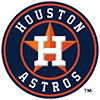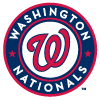In this edition of Nerd Alert, I'd like to shift our attention away from shot locations and their corresponding efficiencies -- i.e. our concern here over the pastthreeweeks -- and towards another fantasy category: rebounding.
There are two metrics that we might call "advanced" ways of analyzing rebounds -- namely, Total Rebound Rate (TRR) and Rebounds per 40 Minutes (REB40). (Both available here.)
TRR is, in the words of Basketball Reference's glossary, "an estimate of the percentage of available rebounds a player grabbed while he was on the floor." The formula for it looks like this: 100 * (TRB * (Tm MP / 5)) / (MP * (Tm TRB + Opp TRB)). The result is expressed in a percentage where the average is 10% -- owing to the fact that there are 10 players on a court, each with (hypothetically) the same chance of grabbing a missed shot.
REB40 is really just rebounds per minute scaled to something like what a starter might play per game. Hoop Data (from where I've gotten most of the data for this post) uses REB40. Basketball Reference, on the other hand, uses REB36 (i.e. rebounds per 36 minutes).
In this post, I'd like to ask -- and attempt to answer -- some basic questions about these two measures of rebounds and how they might better assist the fantasy owner in assessing talent.
The reader will excuse me, I hope, for the brevity of some of these entries. A lot of
In this edition of Nerd Alert, I'd like to shift our attention away from shot locations and their corresponding efficiencies -- i.e. our concern here over the pastthreeweeks -- and towards another fantasy category: rebounding.
There are two metrics that we might call "advanced" ways of analyzing rebounds -- namely, Total Rebound Rate (TRR) and Rebounds per 40 Minutes (REB40). (Both available here.)
TRR is, in the words of Basketball Reference's glossary, "an estimate of the percentage of available rebounds a player grabbed while he was on the floor." The formula for it looks like this: 100 * (TRB * (Tm MP / 5)) / (MP * (Tm TRB + Opp TRB)). The result is expressed in a percentage where the average is 10% -- owing to the fact that there are 10 players on a court, each with (hypothetically) the same chance of grabbing a missed shot.
REB40 is really just rebounds per minute scaled to something like what a starter might play per game. Hoop Data (from where I've gotten most of the data for this post) uses REB40. Basketball Reference, on the other hand, uses REB36 (i.e. rebounds per 36 minutes).
In this post, I'd like to ask -- and attempt to answer -- some basic questions about these two measures of rebounds and how they might better assist the fantasy owner in assessing talent.
The reader will excuse me, I hope, for the brevity of some of these entries. A lot of the work on these sorts of problems is on the data-collection side of things. Luckily, it doesn't really call for much in the way of fleshing out, as the graphs are pretty self-explanatory.
So, as I say, this post is designed to answer some simple questions about advanced ways of measuring rebounding. Accordingly, I've formatted what follows in the form of a Q&A. Note, also, that all data is taken from player seasons, over the last four years, of 40-plus games and 20-plus minutes per game.
Boom, nerd-ahol:
Question: How closely do TRR and REB40 correlate?
Answer: Super closely.
This probably isn't very surprising, but it's still worth asking the question. For the graph below, I've plotted TRR versus REB40 for qualified players over the last three years.
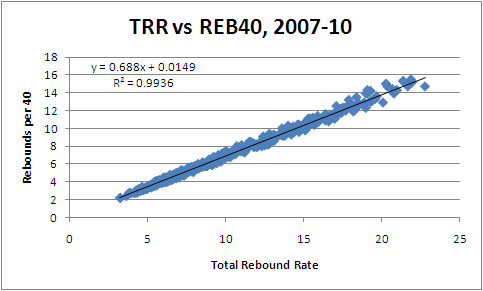
That r-squared is essentially as high as possible and suggests almost perfect correlation between the two.
Basically, if you want to find out how many rebounds a guy will average every 40 minutes, just multiply his TRR by 0.688 and add 0.0149.
Question: Between TRR and REB40, which is better to predict the next season's REB40?
Answer: They're roughly the same, although REB40 is actually slightly better -- and easier.
This surprises me quite a bit actually. I suspected before I ran the numbers that TRR would be more effective, on account of it appears -- at face value -- to be more granular. In fact, this isn't the case at all, as the graphs below suggests.

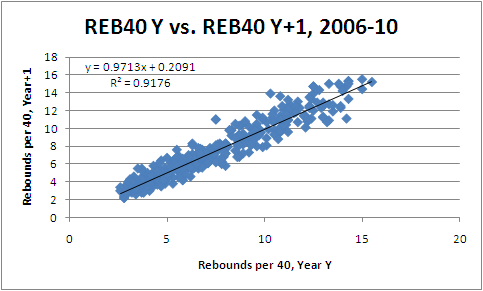
Again, the difference is negligible. But as REB40 is considerably easier to calculate -- and perhaps even slightly more accurate -- there's no reason not to use it as a way of adjudging a player's rebounding ability.
Question: Can we just use one season's rebounds per game (RPG) to predict the next season's RPG?
Answer: Sort of.
As you can see below, RPG actually correlates pretty strongly year to year. We already know that REB40 correlates very strongly season to season, so what we're seeing here is the effect of that minus any changes created by fluctuations in playing time.
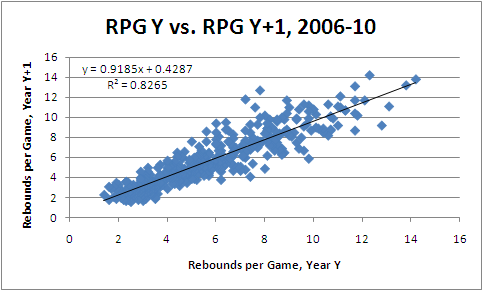
Basically, if you know that DeJuan Blair averaged 6.4 RPG in 18.2 minutes per game (MPG) last season, and you know that he's likely to receive the same sort of playing time this season, then you can guess that DeJuan Blair will probably average about 6.4 RPG. In fact, through 26 games this season, Blair is averaging 6.4 RPG in 19.9 MPG. That's basically the same.
The distinction comes, obviously, when a player receives considerably more or fewer MPGs.
Question: What the hell good is this information?
Answer: I'm getting to that.
I'll get to specific players in next week's edition of Nerd Alert. For now, though, the point is this: from what we know, it appears as though knowing a player's most recent REB40 -- or any kind of per-minute rebound stat -- is a pretty effective means of knowing his future REB40.
It also probably lets us know, in the event that a player begins receiving twice as much playing time, he's also likely to post double the rebounds. (I concede that this is obvious-sounding, but I'll also suggest that it's good practice to establish obvious-sounding things, lest one ends up being wrong and looking like a total jerkbag.)









